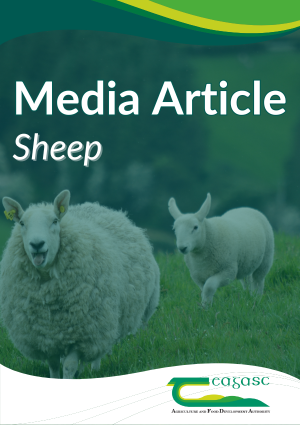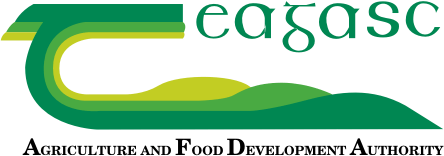
The 2025 National Sheep Conference – The take home messages
The 2025 National Sheep Conference – The take home messages 05 February 2025 Type Media Article By Keith Fahy, B&T Drystock Adviser, Teagasc Galway/Clare There was no shortage of speakers at the Teagasc 2025 National Sheep Conference in the Ard Rí House Hotel in Tuam County Galway with speakers addressing an array of different topics […]
By By Keith Fahy, B&T Drystock Adviser, Teagasc Galway/Clare

The 2025 National Sheep Conference – The take home messages
Type Media Article
By Keith Fahy, B&T Drystock Adviser, Teagasc Galway/Clare
There was no shortage of speakers at the Teagasc 2025 National Sheep Conference in the Ard Rí House Hotel in Tuam County Galway with speakers addressing an array of different topics such as low stress handling, the thin ewe scheme, body condition scoring, botanically diverse swards and the Department of Agriculture Food and the Marine also covered the new mobile Sheep App to notify farm to farm movements.
“Low stress handling for Shepherd and Sheep” was the topic covered by Miriam Parker a UK based Livestock Specialist and owner of Livestockwise Ltd. Miriam discussed important factors when handling and moving sheep. Having worked on the designs in livestock abattoirs, farms and marts across the world her role is to ensure the ease of movement of both cattle and sheep. She also emphasised the main triggers such as:
- Flight Zones – is an animal’s personal space and animals will move away when farmers approach the edge of the flight zone. Flight zones will vary depending on the tameness of animals and whether regularly handled or moved.
- Point of Balance – this is usually at the animals shoulder and where farmers are located will dictate the animals movement i.e. if farmers are behind the point of balance it will direct the animals forward and vice versa.
- Loose Bunching – Typically, sheep will bunch together in corners and this is instinctive behaviour for the animal’s safety.
Miriam also discussed the importance of having penning and handling in order to allow the swift and safe movement of stock for both sheep and shepherd.
Seamus Fagan, who works as a Veterinary Laboratory Inspector with the Department of Agriculture Food and the Marine, discussed the thin ewe scheme and the findings. As part of the study, 75 flocks were analysed for Iceberg diseases. The term is used as there are many more cases of these diseases than reported and that there may be underlying non-visual issues. Seamus listed the five main Iceberg Diseases as per below:
- Maedi Visna
- Caseous Lymphadenitis
- Ovine Pulmonary Adenocarcinoma
- Ovine Johne’s Disease
- Border Disease
As part of Seamus’s work in the laboratory, he analyses thin ewes that have died and does a post-mortem to find the cause of death. Seamus advised farmers to check the teeth of sheep regularly “as sheep can spend up to 12 hours a day grazing”. He also stressed how the back teeth of sheep should also be monitored. Seamus said farmers should feel along the jaw line of sheep externally to feel for any abnormalities. Sheep can develop abscesses in their jaws and teeth and this can create a severe discomfort and reduce grazing time thus increasing the incidences of thin ewes in flocks. Seamus also discussed the issue of Haemonchus in sheep and how the barber pole worm can suck 0.5ml of blood per worm per day, which can be fatal. According to Seamus if bringing fallen animals to the Lab, it is vital to get them there quick, “as the intestine is the first part of the body that starts to go off” and this is vital when analysing the animal.
Next up was Teagasc, Mellows Campus, Athenry based Researcher Dr Frank Campion who discussed Body Condition Scoring (BCS) in sheep and how it is a vital and inexpensive tool to use on sheep farms. Frank spoke about how BCS is a key measure of the nutritional status of sheep. Ewe BCS is assessed by feeling the area along the spine and between the last rib and the hip bone. The three areas to be assessed are:
- Spinal Process
- Transverse Process
- Eye Muscle Area
What is a BCS of 3.0??
- Spine – Smoothed and round
- Eye Muscle – ‘Full Muscle’
- Transverse – Rounded

Source: AHDB
Condition Score Targets
| Time | Target Average |
|---|---|
| Mating | 3.5 |
| Scanning | 3.25 |
| Lambing | 3.25 |
| Weening | 2.5 |
The BCS scoring system goes from 1 to 5 with one being extremely think and 5 being excessively fat.
Frank spoke of the research being carried out on the Teagasc BETTER sheep farms and that 5500 BCS records were obtained from flocks from between the years of 2020-2024. BCS 3-4 was considered “Fit”, <BCS 3 was considered thin and >BCS4 was considered fat. Dr Campion also spoke about how “Thin ewes are usually the ones with the most potential to cause issues and how BCS drives a number of elements of flock performance including pregnancy rate, litter size, feed intake and milk production”. Frank also said that it could take 14 weeks to correct BCS and how thin ewes should be grouped together and fed accordingly. Therefore, it is vital that farmers analyse BCS to ensure animals are in the correct condition to reduce issues, increase efficiencies and boost production.
Dr Sarah Woodmartin who completed her PhD in Teagasc Research Centre in Athenry discussed the topic “Botanically diverse swards – enhancing the environmental sustainability of pasture-based sheep production systems”. Sarah discussed companion forages and how adding red and white clover along with chicory and plantain can boost animals growth rates post weaning while reducing the days to slaughter. “Grazed grass is the most economic feed available” according to Sarah who discussed how she conducted her research by keeping sheep on different sward treatments. Each farmlet composed of 24 Texel cross Belclare ewes and lambs stocked at 11.5 ewes per hectare with lambs being weaned at 15 weeks. The five different treatments included:
- Perennial Ryegrass
- Perennial Ryegrass with White Clover
- Perennial Ryegrass with Red Clover
- Perennial Ryegrass with Chicory
- Perennial Ryegrass with Plantain
Sarah’s research showed that swards with white and red clover had higher sward digestibility and higher crude protein. While there was no major significant difference in lamb growth rate prior to weaning at approx. 240g/day there were increased differences in weight gain across treatments post weaning. Sarah stated that when any companion forage was added to the perennial ryegrass that there was an increase in live weight gain per day. Days to reach slaughter on treatment number 1 was 231 days while treatment 2 was 26 days less, treatment number 3 was 32 days less, treatment number 4 was 27 days less and treatment number 5 was 26 days less. Persistency of some of the herbs was an issue and good grazing practices must be adhered to due to the growing point of some of the companion forages.
You can read more about the National Sheep Conferences 2025 here.
